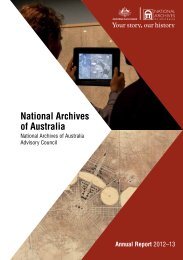National Archives of Australia - Annual reports
National Archives of Australia - Annual reports
National Archives of Australia - Annual reports
Create successful ePaper yourself
Turn your PDF publications into a flip-book with our unique Google optimized e-Paper software.
ReceivablesTrade receivables and other receivables that have fixed or determinable payments that are not quoted in anactive market are classified as ‘receivables’. Receivables are measured at amortised cost using the effectiveinterest method less impairment. Interest is recognised by applying the effective interest rate.Impairment <strong>of</strong> Financial AssetsFinancial assets are assessed for impairment at the end <strong>of</strong> each reporting period.Financial assets held at amortised cost - if there is objective evidence that an impairment loss has beenincurred for receivables, the amount <strong>of</strong> the loss is measured as the difference between the asset’s carryingamount and the present value <strong>of</strong> estimated future cash flows discounted at the asset’s original effectiveinterest rate. The carrying amount is reduced by way <strong>of</strong> an allowance account. The loss is recognised in thestatement <strong>of</strong> comprehensive income.1.12 Financial LiabilitiesFinancial liabilities are recognised and derecognised upon ‘trade date’.Other Financial LiabilitiesOther financial liabilities are initially measured at fair value, net <strong>of</strong> transaction costs. These liabilities aresubsequently measured at amortised cost using the effective interest method, with interest expenserecognised on an effective yield basis.The effective interest method is a method <strong>of</strong> calculating the amortised cost <strong>of</strong> a financial liability and <strong>of</strong>allocating interest expense over the relevant period. The effective interest rate is the rate that exactlydiscounts estimated future cash payments through the expected life <strong>of</strong> the financial liability, or, whereappropriate, a shorter period.Supplier and other payables are recognised at amortised cost. Liabilities are recognised to the extent that thegoods or services have been received (and irrespective <strong>of</strong> having been invoiced).1.13 Contingent Liabilities and Contingent AssetsContingent Liabilities and Contingent Assets are not recognised in the balance sheet but are reported in therelevant schedules and notes. They may arise from uncertainty as to the existence <strong>of</strong> a liability or asset orrepresent an asset or liability in respect <strong>of</strong> which the amount cannot be reliably measured. Contingent assetsare disclosed when settlement is probable but not virtually certain and contingent liabilities are disclosedwhen settlement is greater than remote.1.14 Acquisition <strong>of</strong> AssetsAssets are recorded at cost on acquisition except as stated below. The cost <strong>of</strong> acquisition includes the fairvalue <strong>of</strong> assets transferred in exchange and liabilities undertaken. Financial assets are initially measured attheir fair value plus transaction costs where appropriate.Assets acquired at no cost, or for nominal consideration, are initially recognised as assets and income attheir fair value at the date <strong>of</strong> acquisition, unless acquired as a consequence <strong>of</strong> restructuring <strong>of</strong> administrativearrangements. In the latter case, assets are initially recognised as contributions by owners at the amounts atwhich they were recognised in the transferor accounts immediately prior to the restructuring.70 <strong>Annual</strong> Reports 2010–11



